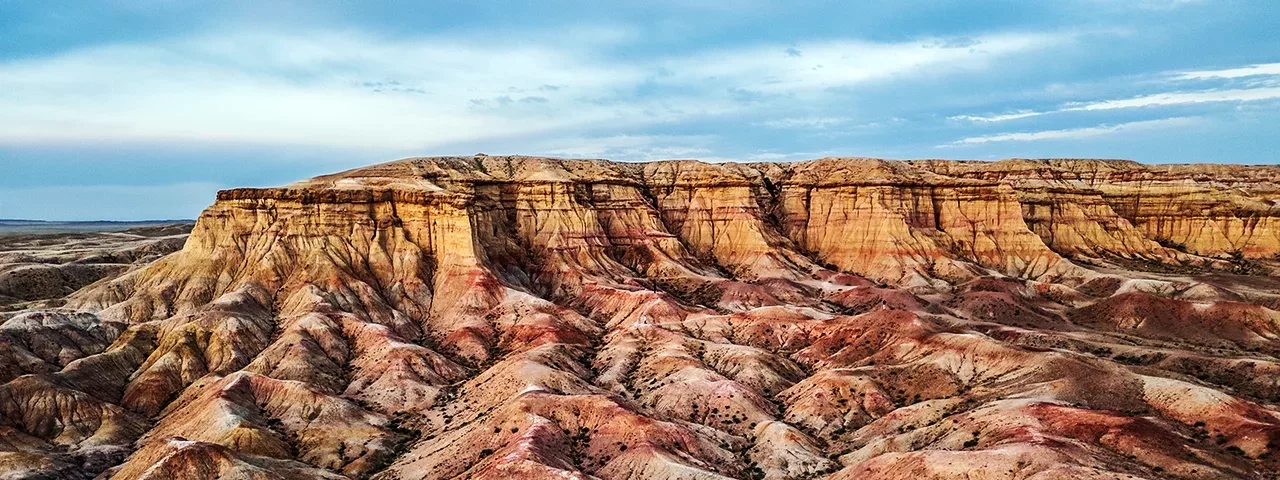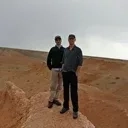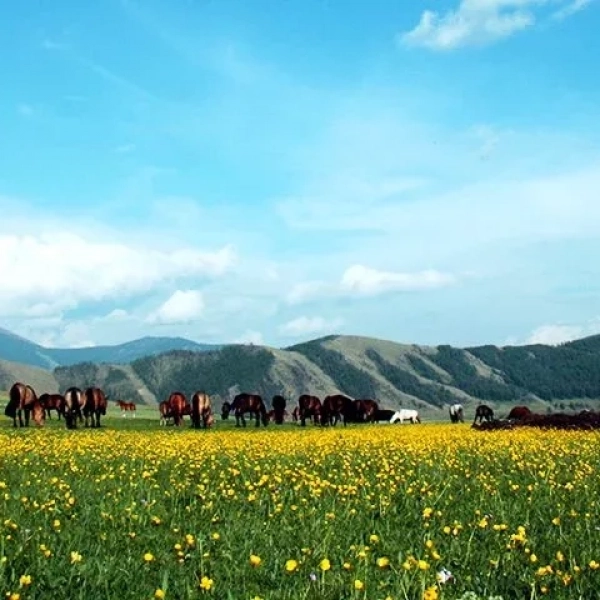Gallery
Itinerary
DAY 1. ARRIVAL IN ULAANBAATAR, BAGA GAZARIIN CHULUU
- Dinner
Welcome to Mongolia! Arrive at Chinggis Khan International Airport, about 50 km southwest of Ulaanbaatar. After completing immigration formalities, meet the local guide and driver and head directly to the northern fringes of the Gobi Desert. Approximately three hours later, arrive in Baga Gazariin Chuluu, or in English – the small place of the stones, a marvelous geological oddity characterized by impressive rock formations. If time permits, get to enjoy a short evening hike to see the sun setting over the stunning rock formations. Then, set in for a first night in the cozy yet simple Mongolian version of a lodge, consisting of traditional felt-made dwellings the nomads of Central Asia often refer to as yurt, and the Mongolians call – ger.
DAY 2. BAGA GAZARIIN CHULUU – TSAGAAN SUVRAGA
- Breakfast
- Lunch
- Dinner
From Baga Gazariin Chuluu, continue the road trip deeper into the Gobi Desert to Tsagaan Suvraga. While in the Mongolian language, the name refers to a 'white stupa,' this is yet another interesting geological phenomenon of colorful sandstone, hinting at the rich mineral deposits hidden within the desert soil – the trigger for the current Mongolian gold rush, which has sparked the recent rapid economic development. Arrive at Tsagaan Suvraga in the afternoon and hike to a beautiful vantage point for a view over the colorful mounds. Overnight in a lodge by Tsagaan Suvraga.
DAY 3. TSAGAAN SUVRAGA – DALANZADGAD – YOLIN AM
- Breakfast
- Lunch
- Dinner
After breakfast, take the not-too-long drive to Del Mountain, featuring fantastic petroglyphs. Walk the mountain top, looking for these magnificent messages from the past before boarding the cars again and driving to Dalanzadgad, the provincial center of the South Gobi. Once a remote desert town, it is today the logistics center for the developing mining industry. Continue driving past Dalanzadgad for another hour to the 'Vulture's Valley' – a beautiful oasis at the foot of the 'Three Beauties' Mountain range. As the sun's rays do not reach the small stream at the creek's basin, it is kept frozen during the beginning of summer (until early July usually). Hence, the place is commonly dubbed the 'Gobi Glacier.' Take a leisurely hike along the beautiful stream and, if lucky, get to see some of the wildlife inhabiting the reserve, thriving on the abundance of freshwater amid the arid desert plains.
DAY 4. YOLIN AM – BAYANZAG
- Breakfast
- Lunch
- Dinner
From the camp, head to Moltsog Els Sand Dunes. Enjoy a ride on the back of the Bactrian, two-humped camel, the icon of the ancient Silk Road. Then, pay a visit to the ger of a local camel herding family. After a friendly cup of tea and a lively chat, drive to Bayanzag, known to Westerners as The Flaming Cliffs. Bayan Zag (Rich with Saxaul) is famed for its red sandstone cliffs, which take on beautiful red and orange hues during sunset. In 1921, the American adventurer Roy Chapman Andrews discovered some of the most critical Paleontological findings of the last century at Bayanzag, ending an ages-long debate on whether dinosaurs were reptiles or mammals. Spend the afternoon exploring the site on foot while waiting for the sun to set the cliffs' aflame' if the weather permits. After sunset, drive to the camp for the night.
DAY 5. BAYAN ZAG - ONG MONASTERY
- Breakfast
- Lunch
- Dinner
Board the vehicles for the long drive north, out of the arid Gobi Desert. In the early afternoon, arrive at Ong Monastery, nestled by the Ong River banks. Though the monastery is practically gone nowadays, the site's name refers collectively to a cluster of monasteries, temples, and Buddhist universities thriving here during the 18th and 19th centuries, serving as one of the largest Buddhist centers throughout the country. Like most religious institutes in Mongolia, the entire complex was destroyed during the anti-religious purges of the 1930s. It is believed that some 200 monks were executed during these purges, and the surviving monks were forcibly conscripted to the Mongolian People's Army. In recent years, local communities and various religious institutes' efforts have resulted in reconstructing the main stupa, leading to its inauguration back in 2004. Arrive in the afternoon at the camp and take a hike through the ancient complex to appreciate its massive scale and witness the ongoing preservation works. Overnight in a ger camp.
DAY 6. ONG MONASTERY - KHARKHORIN
- Breakfast
- Lunch
- Dinner
Drive out of the desert onto the Khangai – Mongolian for fertile land. The arid landscapes would swiftly change into rolling hills and vast grasslands, supporting large herds of livestock, or as they referred to in Mongolia – ‘the five holy animals’ of which the traditional economy consists of. This is where the Khangai Mountains, Mongolia’s second largest mountain range, begins and stretches through the core of the land all the way to Western Mongolia. Early in the afternoon, arrive at Kharkhorin, historically known as Karakorum. This ancient city, built by Ögedei Khan, the son of Chinggis Khan, was once the capital of the Mongol Empire and is now a cornerstone of Mongolia's historical sites. Visit the Monument of Empires, commemorating the 800th anniversary of Chinggis Khan’s coronation, and enjoy the sunset over the sacred Orkhon Valley before retiring to the camp.
DAY 7. KHARKHORIN - KHUSTAI NURUU - ULAANBAATAR
- Breakfast
- Lunch
- Dinner
Leave Elsen Tarakhai, and head to Khustai Nuruu Strictly Protected Area. Khustai was established as part of a unique project to reintroduce the world's last surviving wild horse back to its natural habitat. On the brink of extinction during the previous century, only a very few Takhi or Przewalski's horses were left in zoos around Europe. This graceful steppe horse was returned to Mongolia, and today, thanks to this unique project, several herds roam the Mongolian steppes again. After lunch, drive to a vantage point in the midst of the park to see the herds of horses sprinting from the mountain tops to the narrow river valley, where they come to drink as the temperatures in the lowlands cool down. Late in the evening, after watching the horses, take the two-hour drive to Ulaanbaatar and set in the hotel for a last night in Mongolia.
DAY 8. THE NATIONAL CAPITAL
- Breakfast
- Lunch
- Dinner
Leave the hotel on foot and head to the city center, where modern high-rises are quickly built amid Soviet-era blocks. Begin with a visit to the National History Museum, which holds a permanent exhibition on the different civilizations that have inhabited the territory of Mongolia from prehistoric times to the present. This exhibition includes a significant display of objects from the era of the Great Mongol Empire. Then, take a walk through the central square. Right at the heart of the square, see the figure of D. Sukhbaatar, one of the heroes of the communist revolution of the 1920s, boldly raising his arm towards the statue of Chinggis Khan, the nation's forefather whose name was not allowed to be mentioned during the 70-year communist reign. In a very apt fashion, the square is surrounded by buildings of distinctively different architectural styles. Some are clear evidence of the city’s socialist past, while others serve as a striking testimony to the country’s path to development. After lunch, visit the Choijin Lama Temple. Once the private temple of the Mongolian king, it is today one of the most beautiful Tibetan-Buddhist museums worldwide. The museum holds a well-curated collection of rare Buddhist artifacts that can be seen nowhere else, all displayed in a beautiful early 20th-century temple locked amid modern skyscrapers. In the evening, attend a traditional folk concert featuring unique Mongolian art forms before enjoying a farewell dinner in one of the city’s finest restaurants before reverting to the hotel for the night.
DAY 9. DEPARTURE FROM ULAANBAATAR
- Breakfast
After breakfast at the hotel, drive to Chinggis Khan International Airport for the departing flight out of Mongolia.
Dates & Pricing
16th June, 2026–24th June, 2026
8th September, 2025–16th September, 2025
All prices of Gobi Desert Tour are in US dollars and per person based on twin share occupancy
Rates for private tours:
2 travelers – USD3,131/ person
4 travelers – USD2,687/ person
- Payments facilitated by American Express cards would incur a supplement of 1%
- Mongolian Ways Ltd. reserves the right to change Gobi Desert Tour prices and programs due to changes in flight schedule, changes in airfares, and other local circumstances.
Upgrades (for an ensuite ger- some would have toilets and showers, some just toilets within the ger, limited availability). More information on accommodation in Mongolia.
Baga Gazariin Chuluu: +USD54/ person@twin share | +USD75/ person@single occupancy (1 night)
Tsagaan Suvraga: +USD58/ person@twin share | +USD81/ person@single occupancy (1 night)
Yolin Am: +USD68/person@twin share | +USD87/person@single occupancy (1night)
Bayanzag: +USD58/person@twin share | +USD77/person@single occupancy (1 night)
Ongi Monastery: +USD49/ person@twin share | +USD87/ person@single occupancy (1night)
Kharkhorin: +USD51@person@twin share | +USD70/ person@single occupancy (1 night)
Ulaanbaatar: Best Western Premier 5-stars +USD122/ person@twin share | +USD244/ person@single occupancy (2 nights)
Additional Information
- Accommodation as per program
- Meals as indicated in the program (full board basis)
- Drinking water
- Private 4WD vehicle
- Local English speaking guide
- All entrance fees as per program
- All transfers
- Travel expenses to/from Mongolia
- Travel Insurance
- PCR/COVID tests, or any tests that might be required for international or domestic travel
- Expenses that might incur due to the results of COVID tests before, during or after the tour
- Mongolian visa
- Excess Luggage
- Gratuities
- Expenses of personal nature (food and drinks beyond those provided, laundry, etc.)
- Anything not clearly mentioned in the program
- 2 nights in 4-star hotel in Ulaanbaatar
- 8 nights in ger camp
Note: The listed hotels on Gobi Desert Tour are tentative. Final hotel list shall be confirmed upon placing a booking and paying a deposit.
Testimonials
![Sebastian n Mikhail]()
True to their reputation, Mongolian Ways has lived up to and exceeded the standards of tour guiding....an excellent team, personable, helpful, and extremely well humored. A thoroughly well-planned tour, and the best few night's sleep I have had in a long time.
Sebastian Strassburg, Germany





















